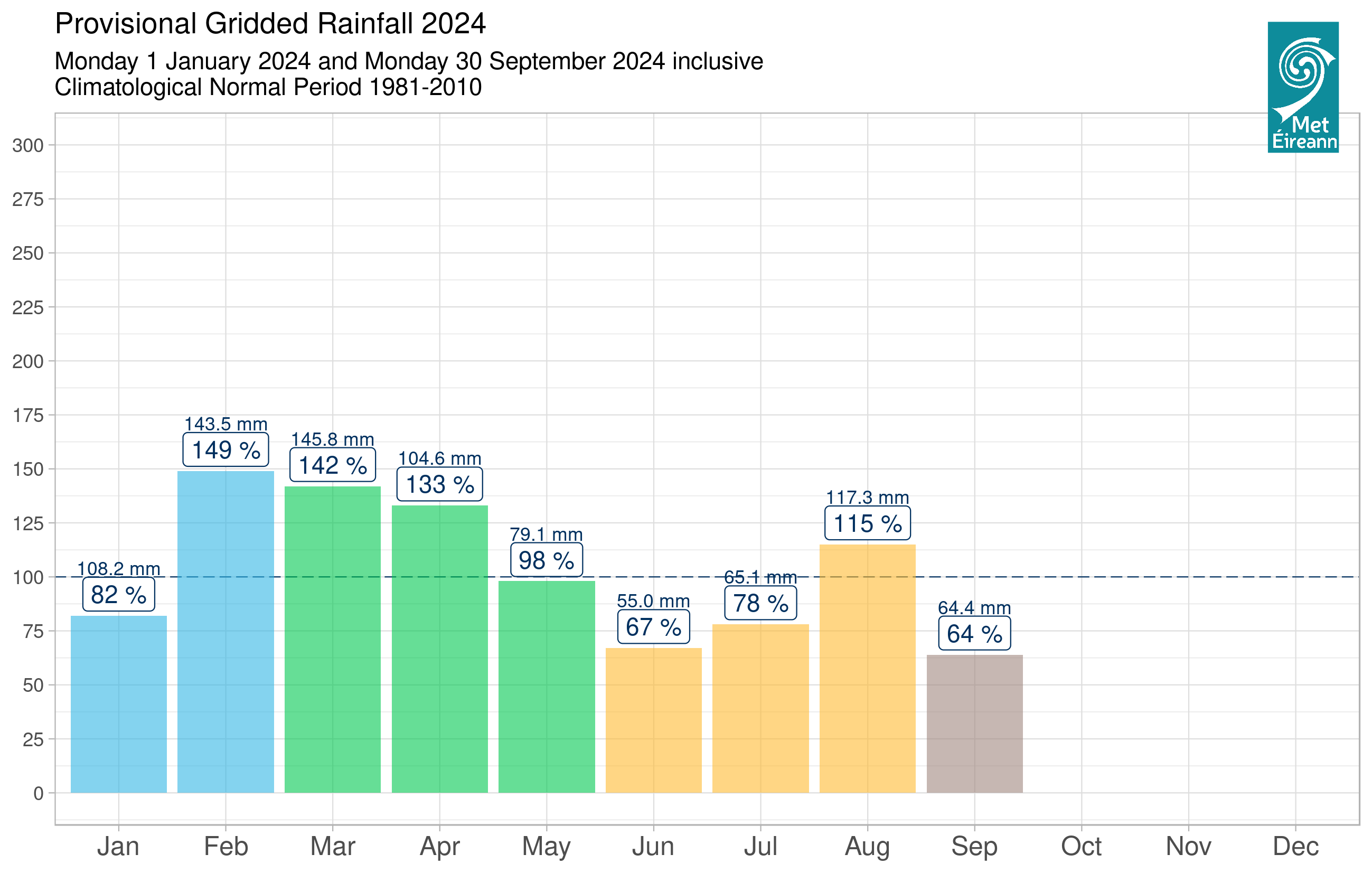Hydroelectric power stations harness the energy of fast flowing water to create clean electricity. We own and operate five hydro stations across the country, which contribute 220MW to Ireland’s electricity system – making them a vital renewable energy source on our path to achieving net zero emissions by 2040.
Each of our hydro stations on the Rivers Shannon, Lee, Liffey, Erne and Clady are unique, and we have to carefully manage water levels at their reservoirs during floods or drought. This means closely monitoring rainfall throughout the year to plan necessary works and anticipate action in response to adverse weather events.
Rainfall and impact on our generation stations
The Met Eireann chart below shows monthly rainfall totals for 2024 to date, and how they compare with previous years. Last winter and spring saw above average rainfall, with drier weather only arriving in May. While there is still plenty of rain around during a normal Irish summer, rainfall is generally lower than at other times of year – and that, combined with the longer, brighter days and growth in vegetation, reduces the amount of water flowing off the land into the rivers and into our reservoirs. This in turn means less water is available to generate electrical power, so the hydro station turbines do not run as often.

Figure 1: Monthly rainfall totals 2024 (provisional)
Copyright: Met Eireann, Source: met.ie. Published under a creative commons attribution 4.0 international. Disclaimer: Met Éireann does not accept any liability whatsoever for any error or omission in the data, their availability, or for any loss or damage arising from their use.
Maintenance Work at our Stations
That makes summer the ideal time to carry out our essential maintenance programmes, to service and repair our turbines, and inspect our dams and structures. Our staff work closely with multiple contracting partners to get everything ready in time for the normally wetter winter months. We are currently completing final maintenance tasks across all hydro stations and are working with the local authorities and state agencies involved with the rivers in preparation for the upcoming winter.
The video below gives an insight into the work that has been underway at our station in Ardnacrusha, Co Clare.
Management of our Stations
It is impossible to predict with certainty what kind of weather or storms we can expect this autumn and winter, as no forecast is available on that timescale.
When rain events occur, we seek to store or divert the large inflows of water to minimise the risk of flooding. Yet the possibility remains that very heavy or sustained rainfall could result in water volumes exceeding the reservoir storage capacity. In those cases, the excess water will flow downstream and may cause flooding. As all our hydro stations and the river systems where they operate are unique, there are different options available to deal with these situations when they occur.
The Lee scheme in Co Cork has two reservoirs one at Carrigadrohid and one further downstream at Inniscarra. When rainfall events occur in the River Lee catchment, we use the available storage in the reservoirs to reduce the peak flows in the river. Normally this means heavy rainfall does not result in flooding. However, if it rains heavily enough for long enough, or when multiple storms occur in quick succession, the reservoirs do not have capacity to store all the rainwater inflow and higher discharges must occur downstream to avoid a risk to dam safety. These higher discharges can result in flooding. For more information on the River Lee, please see our informative infographic which can be downloaded
here.
The Liffey scheme has a large reservoir at Poulaphouca in Co Wicklow which we use to temporarily store rainfall from the Wicklow mountains, when the Middle Liffey from Ballymore Eustace to Leixlip is already experiencing high water levels during heavy rain events. To ensure we do not store too much water at Poulaphouca and risk the safety of the dam if a large storm was to occur subsequently, we discharge water from the reservoir when the Middle Liffey flood has passed. During very wet winters, it will not always be possible to wait until the Middle Liffey has abated. To ensure dam safety, we may have to discharge water from the reservoir when Middle Liffey levels are already high and flooding may occur. For more information on the River Liffey, please see our informative infographic which can be downloaded
here.
The Shannon Scheme (Ardnacrusha) is a diversion hydro scheme, meaning that we divert the water flowing from Lough Derg at Parteen Weir down towards Ardnacrusha generating station. It does not have any large reservoir to use for storage so once we are diverting all the water that the station can safely take, the balance must flow down the old River Shannon channel. If that balance is in excess of the river capacity, then flooding will likely occur. For more information on the River Shannon, please see our informative infographic
here.
The Erne scheme uses water from both Upper and Lower Lough Erne and must be able to pass the large volume of water that flows down from a catchment of that size. We discharge the water out to sea at Ballyshannon as soon as it arrives from Enniskillen, so downstream flooding does not occur. For more information on the River Erne, please see our informative infographic which can be downloaded
here.

